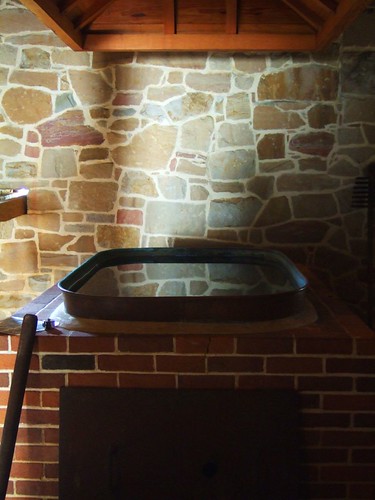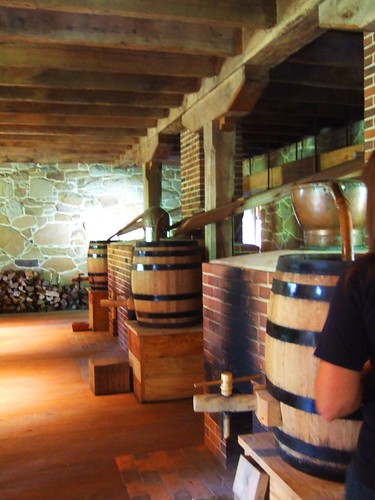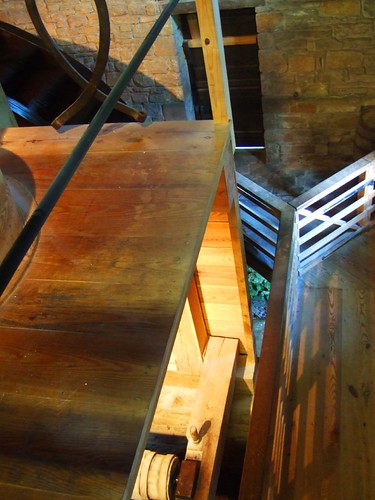 The Whiskey Distillery at Mt Vernon.
The Whiskey Distillery at Mt Vernon.
On day two of my travels in our nation’s capitol, I piled in the car with my friends Bryan and Katie, and made the drive to George Washington’s home, Mt. Vernon.
It was a spectacularly beautiful fall day, and there was no where I would have rather been that driving along the Potomac with the windows down. The three of us lunched at the Mt. Vernon Inn, which offers “…six intimate dining rooms, two with fireplaces, all with colonial charm, colonial servers, and delicious regional and colonial cuisine.”
I had the “Colonial Turkey Pye,” (the “y” makes it old timey) which was ok, but unimpressive. I think the vegetables were from a frozen bag mix, and it had a giant Ritz cracker hat. Bryan had a cup of peanut soup, which I had tried before at the cafeteria at Gettysburg. I had liked it at Gettysburg, but here it tasted like warm peanut butter. Gross.
The main disappointment was that the menu had foods that could have been eaten in the 18th century, like roasted chicken and corncakes, but the foods weren’t at all different from what we eat today. There wasn’t even an effort to use spices appropriate to the 18th century. It’s dull; I never understood why “historic” restaurants never make the effort to offer interesting, delicious historic food.
We spent a few hours touring the grounds, and took a fairly boring tour of the Mansion itself. The house sees a high volume of visitors each year, and the staff handles this by scooting a continuous line of tourists along a velvet-roped route through the interior of the building, while reciting the interpretation for each space on a continuous loop. You would enter the room at the beginning of the interp, and leave approximately when it would start repeating. It was weird. One fact did catch my attention: Washington died suddenly of an inflammation of the throat, that suffocated him in 36 hours. I got a little freaked out when I felt a cold coming on a few days later.
 Next, we went to Mt. Vernon’s second site which features a reconstruction of Washington’s Gristmill and Distillery. I had been looking forward to visiting the recently opened distillery for awhile, and it really was a treat. A knowledgeable interpreter talking us through the distilling process while we toured a truly beautiful building. I learned that in the 18th century, whiskey was made from rye, with a little corn. It was not aged; the entire distilling process took only two weeks before it was casked and sold. The liquor was clear, and our guide described it as tasting surprisingly sweet. Mt. Vernon will begin selling its whiskey sometime in the next year, and I am excited to try it when they do.
Next, we went to Mt. Vernon’s second site which features a reconstruction of Washington’s Gristmill and Distillery. I had been looking forward to visiting the recently opened distillery for awhile, and it really was a treat. A knowledgeable interpreter talking us through the distilling process while we toured a truly beautiful building. I learned that in the 18th century, whiskey was made from rye, with a little corn. It was not aged; the entire distilling process took only two weeks before it was casked and sold. The liquor was clear, and our guide described it as tasting surprisingly sweet. Mt. Vernon will begin selling its whiskey sometime in the next year, and I am excited to try it when they do.The gristmill was also neat, as gristmills are. Every time I stand before a spinning water wheel, and all those gears and grindstones, I’m impressed by human ingenuity. Who thinks of these things??
I picked up a little souvenir treat for myself: a 5-ounce block of American Heritage Chocolate, a product of the Historic Division of Mars, that is made from an authentic Colonial recipe. I’m going to use it to make “Chocolet Puffs,” a receipt from a 18th century manuscript that is one of the earliest instances of chocolate being used in another manner than for drinking. If the recipe turns out well, they will be sold at The City Reliquary’s 1st Annual Haveymeyer Sugar Sweets Festival on Saturday. But more on that tomorrow.
See more images from my trip below.



So I realize that this post is almost a year old, but I just discovered your blog (through the Tenement Museum) and am making my way backward through it, loving every word!
I used to work at Mount Vernon (right after they opened the gristmill) and the cornmeal was THE best I have ever tasted. I managed to get about 5 lbs of it that I kept in the freezer for about a year afterward. Sigh… long gone now, though.
If you’re ever looking for an excuse to come back to VA, keep an eye on the Colonial Williamsburg conference schedule. They had a foodways conference in Nov. ’09 that was incredible and they’ve promised a repeat. You would have loved it. Lot’s of hands (and tastebuds) on opportunities to immerse yourself in 18th century food from hoof and field to table and they served us food made from proper period recipes, plus historic recipes adapted for the modern table (not just the ersatz stuff served at the Inns, Mount Vernon and Colonial Williamsburg).
I had never thought of coming down to Williamsburg for a conference, I will keep an eye on it. I’ve actually *never* been to Colonial Williamsburg, but it is on my to do list!